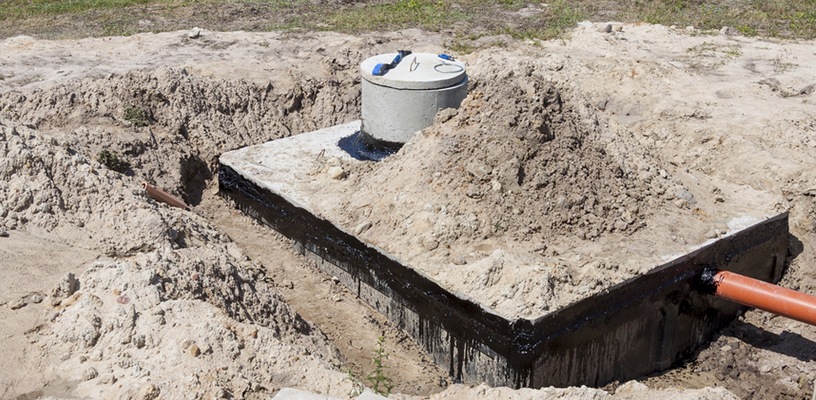
- By Sarah Frantz, MPH, CHES
- Posted Wednesday, September 20, 2017
Get The Low Down On Septic Systems
A septic system is an effective method for collecting, treating, and disposing of sewage in both rural and suburban homes and businesses. They are used throughout every county in North Carolina, and nearly 50% of North Carolina homes have them.
Septic systems are used when a central sewage treatment plant is not accessible to a home or community. This could be because of rural area or cost issues. Septic systems safely treat and dispose of a home’s or business’s wastewaters that are produced in bathrooms, kitchens, and laundry systems. The wastewater that comes from these areas can contain disease-causing germs and pollutants that need to be treated. Gone untreated, they can negatively impact human health and the environment. Septic systems need to be properly used and maintained by the homeowner to make sure they last a long time.
A septic system is made of a septic tank and a drainfield. A septic tank is a watertight container about 9 feet long and 5 feet tall. The tank is buried in the ground near the home. The legally required size of a septic tank is determined by the number of bedrooms in a home. All of the waste from the home flows into the septic tank. When the wastewater flows into the tank, solids and liquids separate. The liquid separates into a liquid layer, and an oily scum-layer, that floats on top of the other liquids. The solids sink to the bottom of the tank, and the liquids and scum layer stay on top. Over time, the liquids move from the tank into the drainfield. The drainfield is an area of the yard that contains buried pipes within trenches below the soil. This area delivers liquids from the tank to the soil, where wastewater treatment takes place as the water filters through the soil.
A properly maintained system is very important. Without it, the septic system can fail and cause many costly issues for a homeowner. It is recommended to have a septic system inspected and have solids pumped and removed every 3-5 years. If a septic system is not used very often, such as at a vacation home, it might not need to be pumped as frequently as a system that is used every day. Make sure the septic tank is getting professionally inspected on a routine basis. Checking for leaks around the house and in the toilet are also very important. A leaky toilet tank releases extra water into the toilet bowl, and down the toilet’s drain. This can flood the entire septic system and cause sewage backup into the home. To check for a leaky toilet, place a couple drops of food coloring in the top water tank. If you see colored water in the bowl, you might have a leak!
There are many things that should not be put into a septic system because they can harm the efficiency of the tank and the drain fields. Being aware of the types and amounts of extra waste materials that are poured down the drain or flushed down toilets is very important. Limiting the use of a garbage disposal will minimize the flow of excess solids to the tank; garbage disposals usually double the amount of solids added to the tank. Do not treat the toilet like a trash can; toilets should only be used to dispose of human waste and toilet paper. Never flush wipes, dental floss, condoms, feminine hygiene products, kitty litter, diapers, paper towels, or pharmaceuticals.
Never pour greases, oils, and fats down the drain. Grease cools and hardens in the pipes and tank and can clog the inlets and outlets, and can ruin the drainfield. Pesticides, paints, paint thinners, solvents, disinfectants, poisons, and other household chemicals should never be dumped down the drain and into the septic tank. This is because they kill the good bacteria that is present in the tank that help disinfect the sewage. Some of these chemicals can also flow through the drainfield and contaminate groundwater beneath it.
Septic tank additives available in stores and seen in commercials are not always necessary. These products include biologically based materials, inorganic and organic chemicals. Some of these additives can contain chemicals that can damage the tank and drainfield, and harm the septic system. Always consult with a professional before using these products.
Keep your septic system running in top shape by getting it inspected routinely, pumping appropriately, managing what goes down the drain and into the tank, and keeping the drainfield clear. To keep the drainfield clear, don’t allow surface waters to flow over the drainfield. Overflow surface waters include water from gutters, downspouts, hoses, pools, etc. You should also keep large trees from growing in the area, don’t plant new trees, and don’t park vehicles or place above ground pools over the area. The septic system is an efficient, inexpensive, and convenient method for treating and disposing of household wastewater when properly treated and maintained.
For more information, view our septic guide at:
http://forsyth.cc/PublicHealth/assets/documents/septic_guide.pdf
You can also view the EPA’s “How To Be A Good Septic Owner Factsheet” at:
a href="http://www.epa.gov/sites/production/files/2016-08/documents/septicsmart_top_10_flyer_final_508.pdf






